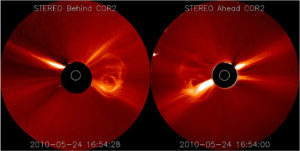Scientists Tackle Grand Challenges In the Earth and Space Sciences In New Special Centennial-Themed Collection

A Coronal Mass Ejection on 24 May 2010 seen by two STEREO spacecraft separated by about 120° in longitude; (left) STEREO‐A/COR2 and (right) STEREO‐B/COR2
One hundred years ago when AGU was founded there were still large unmapped places on our planet and the idea of a person stepping on the moon was a dream. Discovery and wonder have characterized the last 100 years of science as we learned the plates shift, the climate changes, and scientists are studying the Moon, Mars, and beyond in detail. Our species now has a global view of how our planet was formed, how it works, and humans’ role as a planetary process. This fundamental earth and space science has fostered technology we all depend on from GPS to Velcro and a global understanding of earth systems that have improved economic security, public health and safety around the globe. Looking forward earth and space science will be the science for the coming century informing the future of our species on this planet and exploration beyond.
As part of AGU’s Centennial celebration, we are publishing a special collection of papers across AGU journals, exploring where major research and discovery are needed to address fundamental questions in our understanding of Earth and the solar system.
These crucial Centennial topics range from the future of our dramatically changing polar regions to how climate change is affecting disease transmission, from improving earthquake prediction to understanding the amount of water in the Moon’s interior, from predicting weather on Mars to forecasting solar eruptions.
We are proud to announce that the first six papers of this Grand Challenge special collection have been published. They include:
Observing and Modeling Ice Sheet Surface Mass Balance By Jan T.M. Lenaerts et al.
A better understanding of the processes that affect the addition and removal of snow and ice at the top of ice sheets is critical to predicting future behavior of the ice sheets and their effect on sea level, Jan Lenaerts et al. write in Reviews of Geophysics. The authors suggest that, aided by new field, airborne, and satellite observations, improvements to regional-scale models in the past decade have allowed good simulations of ice sheet surface processes. The next step is to extend this knowledge to models that work at a global scale.
Thirty years of regional climate modeling: Where are we and where are we going next? By Filippo Giorgi
Over the past 30 years, regional climate models that allow for more focused analysis of climatic processes and change at regional to local scales have been able to handle ever more detailed and complex data. In a paper in Journal of Geophysical Research: Atmospheres, Filippo Giorgi, one of the pioneers of regional climate modeling, writes that there is still additional scope for regional climate models to be refined and developed further to improve the accuracy and reliability of projections of regional to local climate change. This information is needed for impact and vulnerability assessments, and scientists also need to be able to effectively explain the relevance of the models and data they produce to those responsible for making policy decisions and for implementing practical responses to climate change, he writes.
Forecasting the Structure and Orientation of Earthbound Coronal Mass Ejections By E.K.J. Kilpua
Nearly all strong and extreme space weather disturbances are caused by coronal mass ejections, or CMEs. Forecasting whether a given CME will impact the Earth and how severe the impact will be is essential for our society, but our ability to do so is currently quite modest, Emilia Kilpua et al. write in Space Weather. Improved space weather forecasts will require higher quality observations of CMEs and advanced modeling, according to the authors.
Extracting Auroral Key Local Structures from All-sky Auroral Images by Artificial Intelligence Technique By Qiuju Yang et al.
All-sky auroral imagers (ASIs) that record hundreds of millions of images of aurorae and other electrical activity in the ionosphere around the world are very important for studying space physics, but it is tedious to manually process the large amounts of data. Qiuju Yang et al. write in Journal of Geophysical Research: Space Physics that researchers could use artificial intelligence techniques to automatically recognize and classify aurorae, significantly improving the field.
Forgotten Legacies: Understanding and Mitigating Historical Human Alterations of River Corridors By Ellen Wohl
Deforestation, agriculture, urbanization, altered topography, land drainage and river engineering cause imbalances in river networks, leading to a decline in animal and plant biodiversity and abundance. Understanding past alterations to river networks and their historical impacts will improve our management and restoration strategies, writes Ellen Wohl in Water Resources Research.
Please be sure to check out the in depth article in Eos, Forgotten Legacies: Understanding Human Influences on Rivers
Each of the dozens of topics addressed in the Grand Challenge special collection reviews the history of the topic and the current state of knowledge, while also focusing on the future by describing major unanswered questions and challenges, and discussing what is needed to provide solutions over the next decades.
The papers, which will continue to be published in the coming months, are free to access and are accompanied by additional information to make them accessible to the general reader. Many of the issues have a direct impact on or benefit to society. AGU will use the collection to showcase our science to policy makers, funders and the public.
Earth and space science can have an immeasurable impact on society, but only if it is valued and supported. By reading and sharing articles that are part of the Grand Challenge special collection, you can be part of a global effort to bring public attention to the value of science and accelerate the advancement of science. By reading and sharing articles, you can also be a part of a concerted effort to build support for scientific funding across governments and institutions around the world.
AGU’s commitment to continue pushing the boundaries of knowledge in the Earth and space sciences through these Grand Challenges publications — paired with strong public support for scientific research and collaboration — is essential to the research community’s ability to embark on the next transformative era of Earth and space science.
Editor’s Note: On 7/25, the article by Y. Fan et al. “Extracting Auroral Key Local Structures from All-sky Auroral Images by Artificial Intelligence Technique” was erroneously identified as a Grand Challenge paper. It can now be found in JGR Space Physics.




[…] William & Mary’s Virginia Institute of Marine Science (VIMS) is the lead author of a new “Grand Challenges” paper commissioned to mark the 100th anniversary of the American Geophysical Union (AGU), the […]
[…] study invites scientists to meet the scientific and ethical grand challenge of examining how water cycle modifications affect Earth system resilience. In outlining the grand […]
[…] examine invitations scientists to fulfill the scientific and moral grand challenge of analyzing how water cycle modifications have an effect on Earth system resilience. In outlining […]
[…] study invites scientists to meet the scientific and ethical grand challenge of examining how water cycle modifications affect Earth system resilience. In outlining the grand […]
[…] estudio invita a los científicos a afrontar el gran desafío científico y ético de examinar cómo las modificaciones del ciclo del agua afectan la resiliencia […]